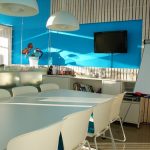 By Albert Cooper
By Albert Cooper
So you’ve launched a startup and have reached a point where you can invest in a physical office space. That’s great news! Leaving your kitchen office/garage/coworking phase means you’ve had enough traction to take your business to the next level. Whether you’ve scored a nice investment deal or simply have good revenue, an office is a great way to bring your team together and continue to explore new growth opportunities.
Your office will become the gateway to high productivity and a good company culture. As such, it’s important that you put plenty of thought and consideration into how you decorate your office and set up your floor plan. Your layout not only dictates how people will navigate the flow of the space, but how they’ll interact with one another and how the space makes them feel. Standard drab, gray colors with metal filing systems and standard gray cubicles can dampen the entrepreneurial spirit. Here are three key factors to consider when designing your startup’s first office.
Incorporate nature
According to the Environmental Protection Agency, the average American spends 93% of their time indoors, so it’s important to bridge the gap by bringing nature to them. Several studies have been conducted to determine the effect of being around plants. Indoor plants can reduce the level of stress people experience in the workplace, and one study even found that workers’ blood pressure lowered when they were in indoor spaces that contained plants, versus those that didn’t. The same study also found that task completion was up 12%, and other studies have similar results regarding the productivity impact of plants.
Pay attention to your desk style
One of the first and most important things you should focus on is your office layout. Your layout should be designed with efficiency in mind, and needs to be designed with the best productivity tips in mind. Many startups opt immediately for the open floor plan/flat table concept. While the open floor plan is certainly a good idea, it doesn’t necessarily mean you should immediately eliminate some privacy from employee to employee. A study conducted by Harvard Business School found that open floor plans simply don’t live up to the hype: open plan offices spent 73% less time on face-to-face interactions.
And while social collaboration is key in today’s startup companies, privacy and concentration are also critical. Research has shown that the need for individuals to have pinpoint focus on their tasks is increasing. The workforce of today want to be able to focus on their tasks without peripheral interruptions; when key cognitive processes are interrupted, it increases the probability of mistakes and halts productivity.
It’s important to understand walled cubicles vs benching cubicles for office use. Instead of simply jumping into the open floorplan concept, consider a compromise, where your staff can have some privacy without being completely cordoned off.
Reflect the brand
Your startup’s branding should play a role in your office design. Lauren Geremia is an interior designer who’s worked with big companies like Instagram to create awe-inspiring offices. During an interview with GQ, she explained how she used different techniques to bring a space to life. During one project with a new technology-based car insurance company called Metromile, Geremia wanted to incorporate a design that reflected the company’s brands and values.
“I wanted to elegantly represent their brand with clever design elements, like matchbox cars in the coffee table, vintage road maps, beaded car seat covers as sound abatement, road trip murals, and convex garage mirrors as wall art,” she said. “We referenced the beauty of classic cars with a material palette of chrome and saddle. Yellow ochres and oxblood reds add retro warmth. These individual conference rooms are the perfect phone call or private conversation space, with the vintage leather T-chairs and beaded car seat covers that are acting as sound abatement.”
Similarly, over at Instagram, she created a large cube shelf, and each cube held a simple vintage camera. This subtle art installation represented exactly what Instagram embodied, and added to the overall aesthetic.
_______
Albert Cooper is a known content writer from California. He writes content in different niches such as social media marketing, finance, business etc. He’s a day time blogger and night time reader currently working as a chief content advisor for some business and finance groups. He enjoys pie, as should all right-thinking people.
